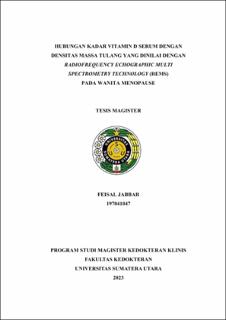Hubungan Kadar Vitamin D Serum dengan Densitas Massa Tulang yang Dinilai dengan Radiofrequency Echographic Multi Spectrometry Technology (REMS) pada Wanita Menopause

Date
2023Author
Jabbar, Feisal
Advisor(s)
Siregar, Muhammad Fidel Ganis
Effendi, Iman Helmi
Metadata
Show full item recordAbstract
Background: Osteoporosis is a common condition, defined by the assessment of
bone density, and associated with an increased risk of bone fractures due to fragility.
Bone mineral density (BMD) is lower in menopausal women due to estrogen
deficiency, age-related decline in osteoblast function, decreased calcium
absorption, and reduced synthesis of Vitamin D, which triggers the occurrence of
osteoporosis.
Objective: To determine the relationship between serum vitamin D levels and
BMD assessed using radiofrequency echographic multi-spectrometry technology
(REMS) in menopausal women.
Methods: This study was an observational analytical research with a crosssectional
design conducted at Prof. dr. CPL University Sumatera Utara Hospital
starting from May 2023. Interviews and physical examinations were conducted to
obtain the characteristics of the research subjects (age, duration of menopause, and
body mass index). Measurement of 25(OH)D levels was performed using PCR
method, and REMS examination was conducted to assess BMD.
Results: Out of 32 menopausal patients, the average vitamin D level was 18.05 ±
5.81, and the average BMD level was -2.13 ± 1.23. The analysis using Spearman
correlation test showed a significant relationship between Serum Vitamin D Levels
and BMD evaluated using REMS in Menopausal Women (p=0.020).
Conclusion: There is a strong correlation between Serum Vitamin D Levels and
BMD evaluated using REMS in menopausal women.
